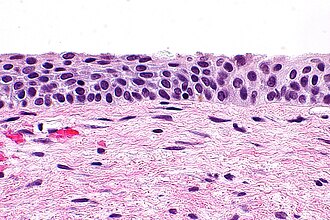Uterine cervix with atrophic changes
(Redirected from Atrophy of the uterine cervix)
Jump to navigation
Jump to search
Uterine cervix with atrophic changes is relatively common and is important to recognize as it can mimic HSIL.
| Uterine cervix with atrophic changes | |
|---|---|
| Diagnosis in short | |
 Atrophic cervix. H&E stain. | |
|
| |
| LM | small squamous cells with grey/blue cytoplasm, no "dancing"/"sparkling" chromatin, no mitoses |
| LM DDx | HSIL, immature squamous metaplasia |
| IHC | p16 -ve, Ki-67 rare basal cells |
| Site | uterine cervix - exocervix |
|
| |
| Clinical history | usually postmenopausal |
| Prevalence | common |
| Prognosis | benign |
| Other | normal - postmenopausal |
It is also known as atrophy of the uterine cervix, cervical atrophy, atrophy of the cervix and cervix with atrophic changes.
General
- Common.
- Post-menupausal.
- Important to recognize and differentiate from HSIL.
Microscopic
Features - squamous cells:
- Cells smaller.
- Cytoplasm grey/blue.
- No "dancing"/"sparkling" chromatin.
- No mitoses.
Notes:
- Mitosis do not exclude the diagnosis.... but should make one think HSIL.
DDx:
- HSIL.
- Immature squamous metaplasia.[1]
Images
www:
IHC
Features:[1]
- p16 -ve.
- Ki-67 rare basal cells.
Sign out
UTERINE CERVIX, BIOPSY: - SQUAMOUS MUCOSA WITH ATROPHIC CHANGES. - BENIGN ENDOCERVICAL EPITHELIUM. - NEGATIVE FOR DYSPLASIA. COMMENT: A p16 immunostain is negative. A Ki-67 immunostain marks rare basal cells.
See also
References
- ↑ 1.0 1.1 Iaconis, L.; Hyjek, E.; Ellenson, LH.; Pirog, EC. (Sep 2007). "p16 and Ki-67 immunostaining in atypical immature squamous metaplasia of the uterine cervix: correlation with human papillomavirus detection.". Arch Pathol Lab Med 131 (9): 1343-9. doi:10.1043/1543-2165(2007)131[1343:PAKIIA]2.0.CO;2. PMID 17824788.
- ↑ URL: http://www.eurocytology.eu/static/eurocytology/TUR/cervical/LP1ContentLcontC.html. Accessed on: 13 December 2013.